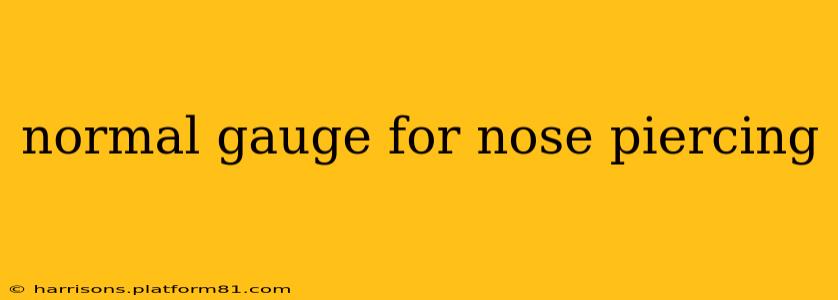Choosing the right gauge for your nose piercing is crucial for both aesthetic appeal and healing. The gauge, measured in millimeters (mm) or gauge number (the smaller the number, the larger the diameter), significantly impacts the look and longevity of your piercing. This guide will explore the most common gauges, factors influencing gauge selection, and address frequently asked questions.
What is the Most Common Gauge for Nose Piercings?
The most common gauge for nose piercings is 20 gauge (0.8mm). This size offers a good balance between visibility and ease of healing. It's thin enough to minimize trauma during piercing, allowing for quicker healing and reduced discomfort. It also creates a subtly noticeable piercing, suitable for most preferences.
What Gauges are Available for Nose Piercings?
While 20 gauge is the standard, several other gauges are used for nose piercings, each with its own considerations:
- 18 gauge (1.0mm): Slightly thicker than 20 gauge, offering a more prominent look. It may take slightly longer to heal.
- 22 gauge (0.7mm): A thinner gauge, resulting in a more delicate appearance. It can be more prone to closure, especially in the early stages of healing.
- 16 gauge (1.6mm): Considerably thicker, rarely chosen for initial piercings, mainly used for stretching an existing piercing.
Choosing a gauge depends on your personal preference, the type of nose piercing (nostril, septum, etc.), and your piercer's recommendations.
What Gauge is Best for a Nostril Piercing?
For a nostril piercing, 20 gauge (0.8mm) is generally recommended. It's a good balance of visibility and ease of healing, making it the most popular choice. A 22 gauge might be chosen for a smaller, more subtle look, but it needs careful consideration due to the potential for faster closure.
What Gauge is Best for a Septum Piercing?
Similar to nostril piercings, 18 gauge (1.0mm) or 20 gauge (0.8mm) is frequently selected for septum piercings. However, septum piercings often allow for more flexibility in gauge size depending on individual anatomy and preference. A piercer can advise you based on your specific anatomy.
Can I Change the Gauge of My Nose Piercing?
Changing the gauge of your nose piercing should only be done by a professional piercer. Improperly changing the gauge can lead to infection, tearing, and other complications. Never attempt to do this at home.
How Do I Know What Gauge My Nose Piercing Is?
If you're unsure of your nose piercing's gauge, a piercer can easily determine it. You can also try measuring the diameter of your jewelry with a ruler, but this isn't always accurate. Professional assessment is recommended for an accurate measurement.
What is the Healing Time for Different Gauges of Nose Piercings?
Healing time for nose piercings depends on factors beyond gauge size, including individual healing abilities, aftercare practices, and piercing location. However, generally, thinner gauges (like 22g) may heal slightly faster, while thicker gauges (18g and above) might require a bit longer. Always follow your piercer's aftercare instructions diligently.
Remember, consulting a professional piercer is crucial for determining the best gauge for your nose piercing based on your anatomy, preferences, and the type of piercing you desire. They can provide expert advice and ensure a safe and successful piercing experience.
